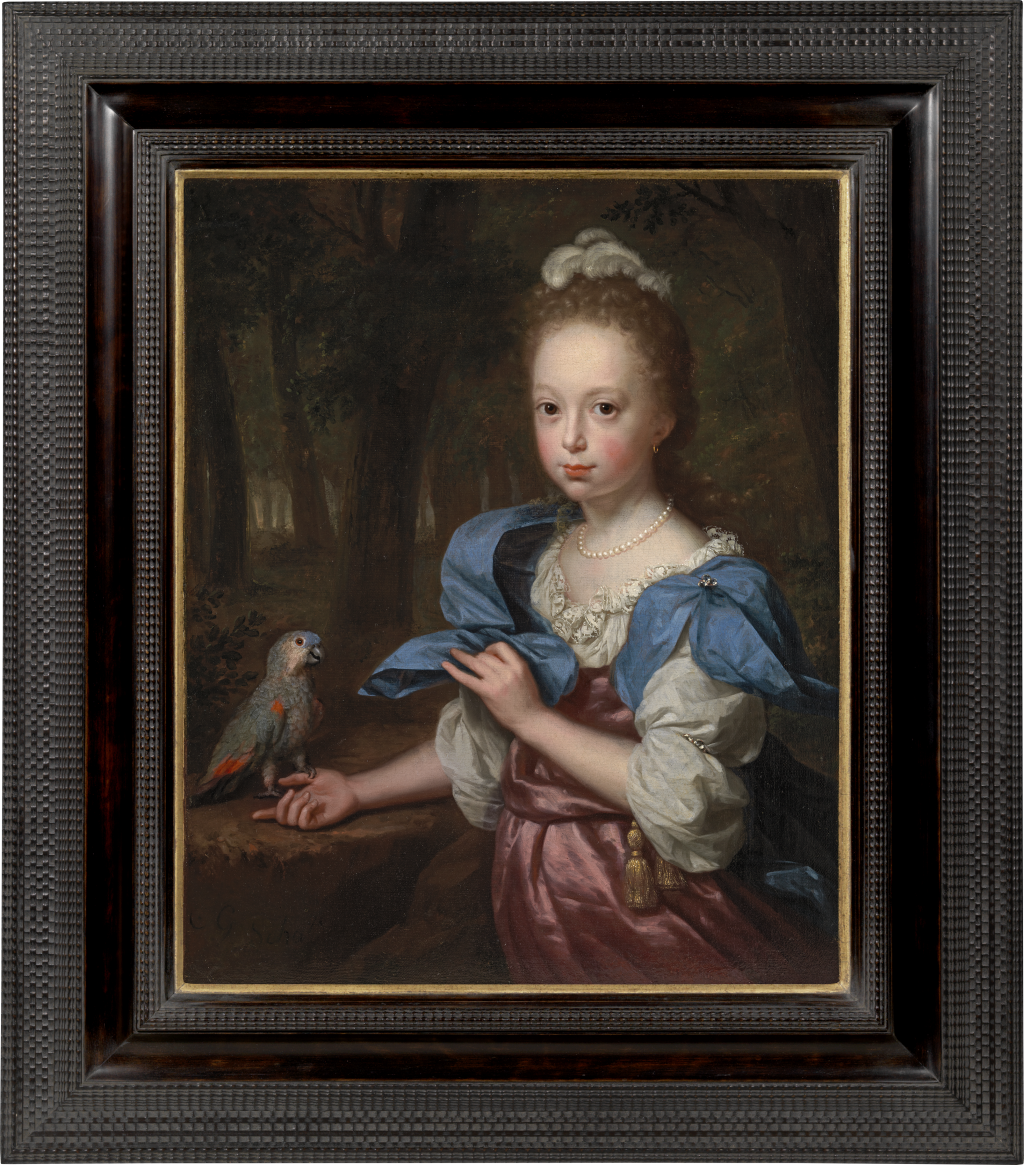GODFRIED SCHALCKEN
Made, near Dordrecht 1643 - 1706 The Hague
Ref: BZ 186
Portrait of a girl in a pink dress, with a parrot in a forest landscape
Signed lower left: G. Schalc
Oil on canvas: 17 x 13¾ in / 43.2 x 34.9 cm
In a black polished Dutch seventeenth century style ripple frame
Painted circa 1692-98
Provenance:
Probably by descent in the Goddard family to Ambrose William Goddard (1892–1987);
John William Hesketh Goddard (1928–2012), North Cerney, Wiltshire;
by descent to his grandchild
Godfried Schalcken studied with the Leiden fijnschilder Gerrit Dou (1613-1675), acquiring his delicacy of touch and sensitivity to light effects. He painted candlelit genre scenes, religious and mythological subjects, but also had a lucrative portrait practice, working in his native Dordrecht and in The Hague, the seat of the Court. From 1692 to 1698 Schalcken worked in England, where from 1688 the Prince of Orange co-ruled as William III with his cousin Mary II. Dutch cultural influence was strong and, according to Houbraken, Schalcken was very successful in London.
This painting, which was unknown to Thierry Beherman when he compiled his catalogue raisonné of the work of Schalcken, published in 1988, may represent a member of the Goddard family, among whose descendants it has been preserved. The girl’s hair, swept high back off her face, suggests a date in the 1690s. The treatment of the drapery, less crisp than Schalcken’s earlier style, may have been influenced by the bravura brushwork of his rival London portraitists, including Sir Godfrey Kneller and Michael Dahl. The pearly complexion of the sitter, with its soft contours and living bloom, is characteristic of Schalcken.
The child is presented on the edge of a forest, dressed in clothes which hover between contemporary dress and a fantastic outfit that might be worn for a masque. A rich blue silk wrap billows around her; her dress is a deep, rose-pink satin, offset by a lace-edged white chemise. The feathers in her hair, the forest and the parrot which she holds set up associations with an ‘Indian Queen’, an exotic creature who treads lightly through poetry and myth. This is a beloved child, displayed almost as an otherworldly being.
Parrots appear frequently in seventeenth century female portraits, their dazzling plumage, as here, complementing the luxurious costume of the sitter. Brought from the Dutch colonies in Brazil and Asia, they became expensive and prestigious pets. They could be taught to speak and in the context of a child portrait symbolized a willingness to learn and a lesson in responsibility towards a ‘lower’ creature. In a hierarchical society, this young girl of the élite would be taught to guide her dependents with kindness but firmness.
The parrot in this painting is a blue-fronted amazon (Amazona aestiva) from South America, known for their intelligence and playful natures. The same species of bird appears in a work by Gerrit Dou, Young woman in a niche with a parrot and cage, c.1660-65 (Leiden Collection, New York).
GODFRIED SCHALCKEN
Made, near Breda 1634 - 1706 The Hague
Godfried Schalcken was born in 1634 at Made, north of Breda, the son of a clergyman, Cornelius Schalckius, and his wife Aletta Lydius, who came from a distinguished Dordrecht clerical family. In 1654 the family moved to Dordrecht, where Schalckius became Rector of the Latin School. According to Houbraken, Godfried was a good student of languages but preferred to paint. He studied with Rembrandt’s pupil Samuel van Hoogstraten (1627-1678) in Dordrecht from 1656-62 and with the fijnschilder genre painter Gerrit Dou (1613-1675) in Leiden, acquiring Dou’s exquisite delicacy of execution.
By 1675 Schalcken was back in Dordrecht, that year becoming ensign of a civic guard company. In 1679 he married Françoise van Diemen, daughter of a wealthy officer from Breda. He became Dordrecht’s most fashionable portrait painter and built up an international reputation for portraits and genre scenes by candlelight. Schalcken also painted Biblical and mythological subjects and portraits historiés, and made etchings. He attracted the attention of wealthy Court patrons at The Hague and in 1691 became a member of The Hague painters’ confraternity.
Schalcken spent 1692-8 in London specialising in portraits, including one of William III by candlelight (Rijksmuseum, Amsterdam). By 1698 he was back in The Hague. In 1703 Schalcken went to Düsseldorf to execute religious works for Johann Wilhelm, the Elector Palatine. He died in The Hague in 1706. Schalcken’s pupils include the portrait and genre painter Carel de Moor (1656-1738) and the candlelight painter Arnold Boonen (1669-1729), as well as his own sister and nephew.
The work of Godfried Schalcken is represented in the British Royal Collection; the National Gallery, London; the Ashmolean Museum, Oxford; the Uffizi, Florence; the Staatliche Kunsthalle, Karlsruhe; the Kunsthalle, Hamburg; the National Museum, Stockholm and the Rijksmuseum, Amsterdam.















